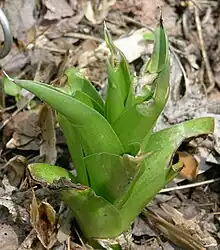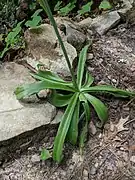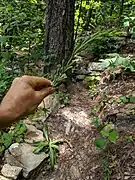| Agave virginica | |
|---|---|
 | |
| Scientific classification | |
| Kingdom: | Plantae |
| Clade: | Tracheophytes |
| Clade: | Angiosperms |
| Clade: | Monocots |
| Order: | Asparagales |
| Family: | Asparagaceae |
| Subfamily: | Agavoideae |
| Genus: | Agave |
| Species: | A. virginica |
| Binomial name | |
| Agave virginica | |
| Synonyms[2] | |
|
List
| |
Agave virginica, synonym Manfreda virginica, commonly known as the false aloe, rattlesnake master, American aloe, Virginia agave,[3][4][5] and eastern agave,[6] is a species of agave. It is native to the central and southeastern United States and northeastern Mexico, where it is found in prairies, upland rocky glades, and sandy open woods.
Description
False aloe is acaulescent, meaning the stem is extremely short. Leaves and flowering stems grow from a bulbous herbaceous caudex. The fleshy green leaves, usually spotted or speckled with maroon, are 10–46 cm (4–18 in) long and 1–6 cm (0.5–2.25 in) across.[6] The leaf margins have fine teeth and leaves taper to a non-spiny tip.[7] Leaf shape and size in Agave virginica vary with soil type, amount of shade, length of cold period, and position of leaf in the rosette. Speckles and spots occur frequently on some leaves in most populations, and some authors have used the informal designation "forma tigrina" for such variants.[8]
In early summer, leafless flower stalks emerge from the basal rosettes of leaves, growing rapidly up to 2.1 m (7 ft) tall. The inflorescence appears June to August, with 10–61 closely spaced flowers grouped in a spike that is about 15–61 cm (6–24 in) long. Each flower, 2–3 cm (0.75–1.25 in) long, is whitish green or yellowish green, essentially tubular, nearly erect, and slender, with a fragrant sweet fruity odor.[7][6] Seed capsules are spherical and 1–1.7 cm (0.4–0.7 in) in diameter.[5]
Distribution and habitat
It is native to an area stretching from North Carolina west to Texas and north to Illinois in the United States and south to Nuevo León and Tamaulipas in Mexico.[3] Its habitat is sunny, well-drained areas in prairies, upland rocky glades, and sandy open woods.[7] It is the only Agave species north of Texas.
Ecology
Agave virginica is adapted primarily to nocturnal pollination by medium-sized moths and larger sphinx moths. Diurnal pollination by large bees results in significantly less seed set than nocturnal and open pollination. Ruby-throated hummingbirds are also attracted to the blooms.[9]
Gallery
 Leaves
Leaves Flowers
Flowers Stem with flowers
Stem with flowers
References
- ↑ NatureServe (5 May 2023). "Manfreda virginica". NatureServe Network Biodiversity Location Data accessed through NatureServe Explorer. Arlington, Virginia: NatureServe. Retrieved 28 May 2023.
- 1 2 "Agave virginica", World Checklist of Selected Plant Families, Royal Botanic Gardens, Kew, retrieved 2019-04-14
- 1 2 "Agave virginica". Germplasm Resources Information Network. Agricultural Research Service, United States Department of Agriculture. Retrieved 21 January 2018.
- ↑ "Manfreda virginica (L.) Salisb. ex Rose". npgsweb.ars-grin.gov. Retrieved 29 October 2020.
- 1 2 False Aloe, Missouri Department of Conservation, retrieved 2020-10-29
- 1 2 3 "Eastern Agave (Manfreda virginica)". www.illinoiswildflowers.info.
- 1 2 3 "Know Your Natives – False Aloe". Arkansas Native Plant Society. 16 July 2015.
- ↑ "Manfreda virginica (Linnaeus) Salisbury ex Rose, Contr. U.S. Natl. Herb. 8: 19. 1903". Flora of North America. eFloras.org. Retrieved 2011-10-22.
- ↑ Groman, Joshua D.; Olle Pellmyr (1999). "The pollination biology of Manfreda virginica (Agavaceae); relative contributions of nocturnal and diurnal visitors". OIKOS. 87 (2): 373–381. doi:10.2307/3546753. JSTOR 3546753.
